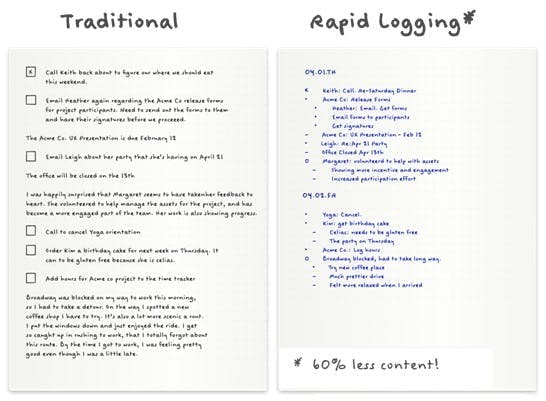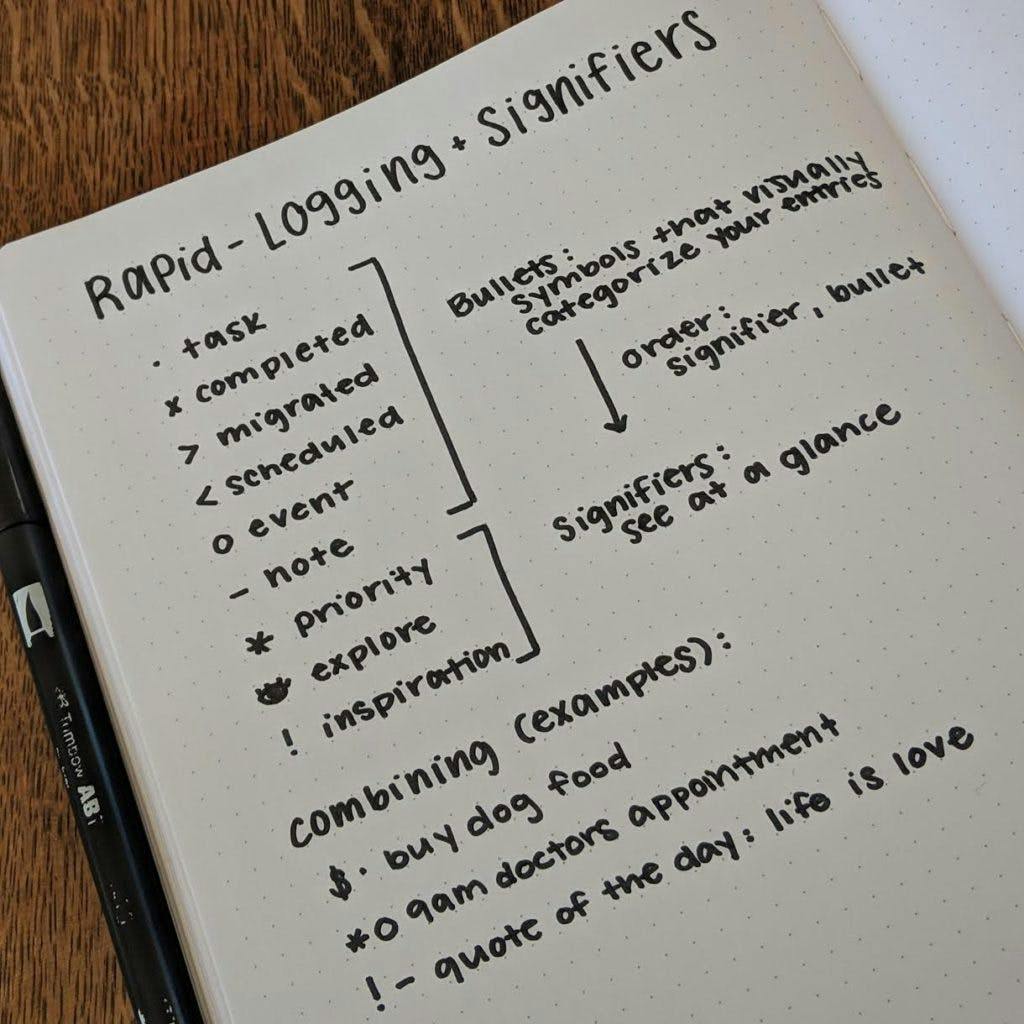The Fundamentals of Rapid Logging

There has been a progressive rise in popularity of bullet and digital journals, but the images you’ll find on social media often highlight aesthetic over form.
While it’s completely understandable that people want to present their artistic aptitudes, the fundamental purpose of bullet journaling rests on pure, barebones functionality: Rapid Logging.
According to Bullet Journal, “Rapid Logging is the language in which the Bullet Journal is written,” suggesting that effective journaling practices begin with learning how exactly to do it.
What is Rapid Logging?
Though it sounds like a woodcutter’s dream, rapid logging is creative, not destructive. At its core, it’s a methodology of penning information in an intuitive, efficient manner. It can be thought of as a more sophisticated to-do list, encouraging the nesting of sub-points and use of symbols and references.
It’s a philosophy that favors succinct and minimalist writing, with the main intention of delivering the necessary information with as little content as possible, as illustrated by the Bullet Journal website:

As it’s comparable to a to-do list, BuJo beginners first experience Rapid Logging when making the Daily Spread, a daily list dedicated to the tasks and events of a single day. However, as it’s simply a stylized process of capturing your thoughts and ideas, it can be applied within any section of your bullet journal, including the weekly or monthly spread.
We don’t need to pretend that Rapid Logging is space technology or straight-up wizardry; it’s simply a practice of displaying information to promote self-determination and create healthier habits, with the ultimate intention of increasing your productivity and long-term accomplishment.
How Do I Rapid Log?
Contrary to traditional bullet-pointing or to-do lists, which don’t usually employ numerous constituents, Rapid Logging, as told in Bullet Journaling 101, is four parts: topics, page numbers, short sentences, and bullets.
1. Topic
Before rapid logging, be sure to title the section, even if only to get into better organization patterns. Titling a section makes later reference easier and helps to maintain the focus of the page, ensuring content is relevant to the topic.
2. Page Numbers
Journaling is unlike diary entry in the sense that there is real emphasis on interweaving sections so that they communicate and inform each other, maximizing efficiency and especially useful to consecutive spreads.
When Rapid Logging, referencing with page numbers helps you not only to better retain that information but reduces planning time by letting you quickly find date-related entries, allowing you to commit to more active work.
3. Short Sentences
Hey, it’s called Rapid Logging for a reason. It’s important to keep your ideas concise in efforts to work to the minimalist nature of the method. While your rapid log will be unlikely to win any prizes for literature, keeping everything short will free your mind of clutter and unnecessary details.
Anyone who is at all familiar with an Asian language knows that they are fairly literal, with linguistic structures that are more practical and consistent than English. For example, in Vietnamese, it is perfectly fine to say, “I read book 3 o’clock tomorrow,” eliminating verb tenses (will), articles (a/the) and prepositions (at). Rapid Logs should be written in this rudimental format.
While grammar facilitates meaning, it often carries no explicit meaning itself, hence no need to write full sentences in your journal. Further, as the information is all pertinent to your own life, you’re likely able to recall things from astonishingly little.
4. Bullets
A big fat splodge is oftentimes the pictorial representation of the bullet point, but there are no limitations with your rapid log. You are free to use a multitude of specific symbols to signify type or priority of tasks and recurrence or migration of events.

(Image taken from 2idea)
As it’s a dynamic task list, it is designed to be updated. Innovative use of bullet points can manage this, by adopting various symbols to signify tasks either not started, in progress or complete. Likewise, due to great versatility, Rapid Logging is applied to various sections of the journal, such as the weekly spread, and even long-term pages like the future log.
Why is Rapid Logging Important?
Obviously, you have complete freedom to arrange your life as you see fit, but implementing more refined, efficient organization tactics brings with it some great benefits.
1. Bite-sized Blocks
Rapid logging is the heart of your journal, whether it’s digital or paper, so it’s obviously important. When we’re considering our current tasks or future ambitions, it’s easy to begin a kind of thought-rambling. Rapid Logging is the instant step away from this brain fog, allowing you to segment larger, seemingly impossible projects into manageable tasks.
In a 2011 study surrounding the impact of progress indicators during tasks (i.e. ‘50% complete’), Frederick G. Conrad et al found that “progress indicators had a substantial impact on users' decisions to continue or break off,” concluding that “the display of progress information can change users' perception of the task difficulty and duration.”
In much the same way, Rapid Logging is a framework where you can mentally think of larger tasks as shorter, while visually observing your progress through completed checked items on the page.
2. Plan into Action
Data entry isn’t known as the most thrilling of jobs, found by Automation Anywhere to be the “most hated” computer task. So it follows that long-winded, traditional note-taking is equally counter-productive to your productivity and realization of targets.
The cumbersome full-form writing of complicated entries discourages you from the activity of planning, thus weakening goal-commitment. Effective journaling practices, such as Rapid Logging, promote minimalism for a very simple reason: planning shouldn’t be arduous, but rather the essential step before action.
Planning is the precondition for success, integral for performing at our highest level. Accordingly, a 2020 study found that students who regularly wrote about their personal goals and plans (of any type) experienced greater results at university; the “goal-setting cohorts demonstrated over 20% higher academic performance, as compared to the two control cohorts.”
3. Customization, Control, Well-being
Rapid Logging is a master list, capable of presenting precisely what you need it to. The flexibility afforded by such a system means that you can fully customize your page, down to specific terminology and symbols. Such customization generates a greater sense of control over your schedule, a major precondition for self-efficacy.
By taking a more active role in the structure of your planning, as opposed to more passive examples such as marking a calendar or basic note taking, you can more effectively manage tasks, targets and deadlines, instilling the healthy ideology that you have control on even the most stressful and difficult of responsibilities.
In their June 2020 entry in the Journal of Vocational Behavior, Allison S. Gabriel et al asked the question: “When does feeling in control benefit well-being?” 41 nurses provided 240 daily diary entries that self-evaluated their perceived level of control in relevant past events.
The study found that “perceptions of control over events were a key driver of well-being,” with the subsequent suggestion that “building efficacy related to enacting control could be helpful [against burn-out].” In essence, a feeling of control, which Rapid Logging and bullet journaling provides, can directly affect your mentality, instilling you with a more positive attitude towards the work and duties in your life.
What About Digital Rapid Logging?
While the official BuJo site says “all you need is pen, paper and 4 minutes,” many now find you don’t even need that. Digital Bullet Journals offer great convenience whilst retaining the creative possibilities of physical notebooks. With Rapid Logging in mind, there are some notable advantages.
1. Digital Convenience
A digital format, like Friday, gives users the option to differentiate their tasks between a current list and a future list. You can see how it all works in the video below:
One major downside to Rapid Logging in a paper journal is that, as your ideas flow naturally, it can become progressively harder to keep things in chronological order. However, with digital, you can seamlessly assimilate future into present, with a dedicated migration feature.
Once more contemplating the fact that it’s called Rapid Logging, let us look to a study from 1988, which found that “[two-finger] typing speed was over five words per minute (wpm) faster than handwriting.” Clearly, digital journals accommodate faster entries and better movement of said information, with further improvements to efficiency, thanks to automated functions, such as routines or task recurrence.
2. Shortcuts and Options
Friday’s Posts allow individual users to compile notes, based on certain topics (ideas, announcements, meeting notes, etc.). With built-in options and shortcuts for creating headings (“topics”), lists (“bullets”) and even images, users can create a rich Rapid Log effortlessly.
At the same time, the format still retains true flexibility as users are free to work with a blank page, meaning they have the choice to enact their own unique methods.
3. Team Rapid Logging
Rapid logging within a work journal benefits further from digital providers, as there is inherently better communication. The Posts feature can be shared and used as team notes, thus creating a centralized forum in which many members of a team could collaborate together, discuss ideas and give instant feedback.
Rapid Logging Leads to More Productive Habits
The precise stepping stones from plan to action, idea to reality, are almost always hidden, so there’s no one solution to success. In what can be quite a hazy situation, however, Rapid Logging is the first jump towards more organized, productive habits.
Ryder Carroll, creator of Bullet Journaling, says himself that “Rapid Logging will help you efficiently capture your life as it happens so that you may begin to study it.” The trick, then, is that Rapid Logging is the continuous effort of recording your thoughts to better understand yourself, your aspirations, and the best working practices to realize them... and it can all start with a single bullet point.



